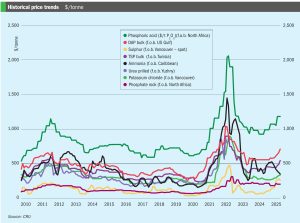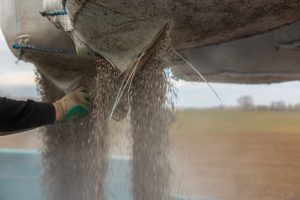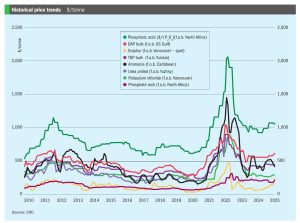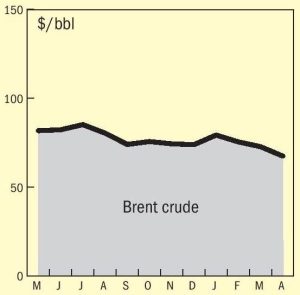
MustGrow and Phospholutions sign distribution agreement
Phospholutions entered into a distribution agreement for RhizoSorb with MustGrow in June.

Phospholutions entered into a distribution agreement for RhizoSorb with MustGrow in June.

Price trends and the market outlook, 19th June 2025

Arkema's John Suldickas, Heather McKay and Juan Gonzalez Leon explore innovations in fertilizer dust control.

OCP Group subsidiary OCP Nutricrops has announced a major investment to expand its phosphate fertilizer production capacity by nine million tonnes by 2028.

Price trends and the market outlook, 10th April 2025

President Donald Trump delayed his ‘liberation day” tariffs by three months on 9th April, while simultaneously ramping up levies on China. In this latest twist to the on-off US tariffs saga, the Trump administration’s 90-day pause on additional duties should provide international suppliers to the world’s biggest fertilizer market with some respite – for now. With the exception of China, the US will now cut back its so-called ‘reciprocal tariffs’ to 10% for the duration of a three-month suspension period. The European Union’s tariff is now halved to 10%, for example, with the trade bloc also pausing its trade countermeasures against the US.

The Sulphur Institute (TSI) held its World Sulphur Symposium in Florence from April 8th-10th.

Sulphur markets have been on a tear over the past few months, driven by strong demand in Asia, with buyers primarily sourcing from the Middle East and Canada through late 2024 and into the early months of 2025. Steady buying from Indonesia and China, the two largest importers of sulphur, appears to have supported the market, in China’s case mainly for phosphate production as well as a variety of industrial processes, and in Indonesia’s case to feed the high pressure acid leach (HPAL) plants that are producing nickel for the battery and stainless steel industries. Prices saw a notable rally following the Chinese Lunar New Year celebrations. Nevertheless, this momentum finally began to shift as April began ago as the pace of price increases in Asia started to slow. As the spring fertilizer application season in China draws to a close, domestic prices began to drop, reaching the equivalent of a delivered price of around $272/t c.fr. As well as the narrowing window for spring application of phosphates, the decline was also driven by weakening demand amid uncertainty over tariffs and export restrictions. In southern China, phosphate producers continue to purchase import cargoes. A major phosphate producer in southwest China has been reported as having bought mainstream material at a price of $303/t c.fr, according to local market sources. Total sulphur port inventories in China had declined by 22,000 tonnes to 1.86 million tonnes by 16 April 2025. The volume at Yangtze River ports increased to 825,000 tonnes, while the port inventory at Dafeng decreased to 400,000 tonnes.

Verdant Minerals says it has been granted two key productive mineral leases for its Ammaroo Phosphate Project by the Northern Territory government. The company says that this significant milestone advances one of the world's largest undeveloped phosphate resources, located about 220km southeast of Tennant Creek. Acting Chief Minister and Minister for Mining and Energy, Gerard Maley, stated, “This is a significant milestone in progressing a world-class resource project that will support jobs, drive investment, and strengthen the NT’s position as a leader in resource development.”

I am writing this freshly returned from the Sulphur Institute’s annual Sulphur World Symposium in Florence (for more on that see pages 24-25), where one of the topics causing some excitement was the anticipated commissioning of a demonstration plant for Travertine Technologies’ new Travertine Process. The plant is due to be commissioned at the Sabin Metals site near Rochester, New York in mid-2025 at a cost of $10.7 million. Capacity is put at “hundreds” of tonnes per year of gypsum processed, and removing “tens” of tonnes per year of CO 2 from the atmosphere.